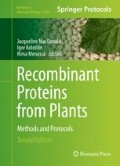Abstract
Rice seeds are an ideal production platform for high-value recombinant proteins in terms of economy, scalability, safety, and stability. Strategies for the expression of large amounts of recombinant proteins in rice seeds have been established in the past decade and transgenic rice seeds that accumulate recombinant products such as bioactive peptides and proteins, which promote the health and quality of life of humans, have been generated in many laboratories worldwide. One of the most important advantages is the potential for direct oral delivery of transgenic rice seeds without the need for recombinant protein purification (downstream processing), which has been attributed to the high expression levels of recombinant products. Transgenic rice will be beneficial as a delivery system for pharmaceuticals and nutraceuticals in the future. This chapter introduces the strategy for producing recombinant protein in the edible part (endosperm) of the rice grain and describes methods for the analysis of transgenic rice seeds in detail.
Access this chapter
Tax calculation will be finalised at checkout
Purchases are for personal use only
References
Wakasa Y, Yang L, Takaiwa F (2009) Production of bioactive peptide in transgenic rice seed. In: Modification of seed composition to promote health and nutrition. Hari Krishnan (ed.), Agronomy monograph series, vol 51. ASA and SSSA, USA, pp 101–120
Stoger E, Ma JK-C, Fischer R et al (2005) Sowing the seeds of success: pharmaceutical proteins from plants. Curr Opin Biotechnol 16:167–173
Wakasa Y, Takagi H, Wakanabe N (2015) Concentrated protein body product derived from rice endosperm as an oral tolerogen for allergen-specific immunotherapy—a new mucosal vaccine formulation against Japanese cedar pollen allergy. PLoS One 10, e0120209
Onda Y, Kawagoe Y (2011) Oxidative protein folding. Selective pressure for prolamin evolution in rice. Plant Signal Behav 6:1966–1972
Krishnan HB, Franceschi VR, Okita TW (1986) Immunochemical studies on the role of the Golgi complex in protein-body formation in rice seeds. Planta 169:471–480
Kawakatsu T, Yamamoto MP, Hirose S et al (2008) Characterization of a new rice glutelin gene GluD-1 expressed in the starchy endosperm. J Exp Bot 59:4233–4245
Pelham HR (1990) The retention signal for soluble proteins of the endoplasmic reticulum. Trends Biochem Sci 15:483–486
Nilsson T, Warren G (1994) Retention and retrieval in the endoplasmic reticulum and the Golgi apparatus. Curr Opin Cell Biol 6:517–521
Stoger E, Vaquero C, Torres E, Sack M et al (2000) Cereal crops as viable production and storage systems for pharmaceutical scFv antibodies. Plant Mol Biol 42:583–590
Wakasa Y, Takaiwa F (2013) The use of rice seeds to produce human pharmaceuticals for oral therapy. Biotechnol J 8:1133–1143
Cabanos C, Eryo A, Amai Y et al (2012) High-level production of lactostatin, a hypocholesterolemic peptide, in transgenic rice using soybean A1aB1b as carrier. Transgenic Res 22:621–629
Qu LQ, Takaiwa F (2004) Evaluation of tissue specificity and expression strength of rice seed component gene promoters in transgenic rice. Plant Biotechnol J 2:113–125
Yang L, Wakasa Y, Kawakatsu T et al (2009) The 3’-untranslated region of rice glutelin GluB-1 affects accumulation of heterologous protein in transgenic rice. Biotechnol Lett 31:1625–1631
Dunwell JM, Wetten AC (eds) (2012) Transgenic Plants - Methods and Protocols. Methods in molecular biology, vol 847 Springer, USA
Wakasa Y, Takagi H, Hirose S et al (2013) Oral immunotherapy with transgenic rice seed containing destructed Japanese cedar pollen allergens, Cry J 1 and Cry J 2, against Japanese cedar pollinosis. Plant Biotechnol J 11:66–76
Takaiwa F, Hirose S, Takagi H et al (2009) Deposition of a recombinant peptide in ER-derived protein bodies by retention with cysteine-rich prolamins in transgenic rice seed. Planta 229:1147–1158
Howell SH (2013) Endoplasmic reticulum stress response in plant. Annu Rev Plant Biol 64:477–499
Wakasa Y, Hayashi S, Takaiwa F (2012) Expression of OsBiP4 and OsBiP5 is highly correlated with the endoplasmic reticulum stress response in rice. Planta 236:1519–1527
Hayashi S, Wakasa Y, Takahashi H et al (2012) Signal transduction by IRE1-mediated splicing of bZIP50 and other stress sensors in the ER stress response of rice. Plant J 69:946–956
Onda Y, Kumamaru T, Kawagoe Y (2009) ER membrane-located oxidoreductase Ero1 is required for disulfide bond formation in the rice endosperm. Proc Natl Acad Sci U S A 106:14156–14161
Author information
Authors and Affiliations
Corresponding author
Editor information
Editors and Affiliations
Rights and permissions
Copyright information
© 2016 Springer Science+Business Media New York
About this protocol
Cite this protocol
Wakasa, Y., Takaiwa, F. (2016). Analysis of Recombinant Proteins in Transgenic Rice Seeds: Identity, Localization, Tolerance to Digestion, and Plant Stress Response. In: MacDonald, J., Kolotilin, I., Menassa, R. (eds) Recombinant Proteins from Plants. Methods in Molecular Biology, vol 1385. Humana Press, New York, NY. https://doi.org/10.1007/978-1-4939-3289-4_16
Download citation
DOI: https://doi.org/10.1007/978-1-4939-3289-4_16
Publisher Name: Humana Press, New York, NY
Print ISBN: 978-1-4939-3288-7
Online ISBN: 978-1-4939-3289-4
eBook Packages: Springer Protocols

